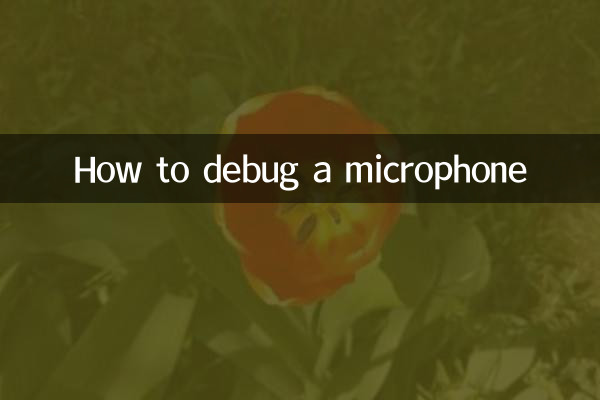How to debug a microphone: Popular topics and practical guides on the entire network in the past 10 days
In today's multimedia era, microphone debugging has become a key link in live broadcast, conference, recording and other scenarios. This article will combine popular topics across the network for nearly 10 days to provide you with a structured microphone debugging guide to help you quickly master the skills.
1. Hot microphone related topics on the entire network in the past 10 days

| Ranking | Hot Topics | Discussion hot topic | Main Platforms |
|---|---|---|---|
| 1 | Live microphone howling solution | 85,200+ | B station, Douyin |
| 2 | Professional recording microphone purchase guide | 62,400+ | Zhihu, Xiaohongshu |
| 3 | Troubleshooting of wireless microphone connection | 47,800+ | Baidu Post Bar |
| 4 | Mobile phone karaoke microphone debugging skills | 39,500+ | Kuaishou, Weibo |
| 5 | Conference room microphone echo cancellation | 28,300+ | Professional audio forum |
2. Basic steps for microphone debugging
1.Hardware connection check
Make sure the microphone is correctly connected to the device, check whether the interface is loose and whether the wire is intact. For wireless microphones, confirm that the frequency matching of the receiver and transmitter is to be confirmed.
2.Volume level settings
Adjust the microphone gain to the appropriate position, neither too small to cause weak sound nor too large to cause distortion. The ideal state is that the peak is between -12dB and -6dB.
3.EQ balance adjustment
Adjust the equalizer according to the usage environment and sound characteristics:
| Frequency band | Adjustment suggestions | Effect |
|---|---|---|
| 80-250Hz | Appropriate attenuation | Reduce low-frequency buzzing |
| 250-800Hz | Fine adjustment | Improve sound thickness |
| 1k-5kHz | Moderate improvement | Enhance clarity |
| 5k-16kHz | Slightly lifted | Increase air feeling |
3. Frequently Asked Questions
1.Eliminate howling
Adjust the relative position of the microphone and speaker to avoid direct opposition; reduce the microphone gain; use feedback suppressor; attenuate the whistling frequency band in EQ.
2.Solve noise floor problems
Check whether the grounding is good; use a balanced connection method; add noise reduction; replace a higher quality microphone or audio interface.
3.The sound is dull
Appropriately increase the high frequency (above 5kHz); check whether the microphone spray shield is too thick; adjust the microphone pick-up angle; consider changing to a brighter microphone model.
4. Key points for debugging in different scenarios
| Use scenarios | Key parameters | Special precautions |
|---|---|---|
| Live broadcast/K song | Compressor, reverb | Pay attention to real-time effect processing |
| Professional recording | Low cut, dynamic range | Maintain original sound quality |
| Conference System | Automatic gain, echo cancellation | Ensure speech clarity |
| Outdoor use | Windproof cover, anti-interference | Coping with environmental noise |
5. Advanced debugging skills
1.Multi-microphone phase alignment
When using multiple microphones, make sure that their phases are consistent and avoid canceling each other. It can be adjusted through waveform observation or special phase detection tools.
2.Dynamic processing
Use compressors and limiters reasonably to control the dynamic range of sound to make them more balanced and stable. It is recommended to try the compression ratio starting from 2:1.
3.Environmental adaptation
In different acoustic environments, the microphone parameters should be re-debuged. Environments with strong sound absorption may require higher frequencies, while environments with high reverb require enhanced directionality and reduced gain.
With the above structured guidance, you should be able to cope with most microphone debugging needs. Remember, good sound effects often require patient and meticulous adjustments, and practice is the best teacher.

check the details

check the details